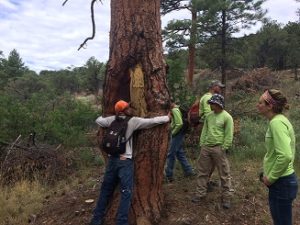Connecting Ecological and Human Health
The Healthier Rural West summit provided an opportunity to connect our efforts to support healthy ecosystems with innovators making our human communities healthier. On March 20th, Nick Goulette from the Watershed Research and Training Center, Jennifer Hansen, Utah’s Wildfire Risk Reduction Coordinator, and Zander Evans from the Forest Stewards Guild presented aspects of fire adaptation to an audience of healthcare professionals and advocates.
Nick outlined the fundamental challenge of an expanding Wildland Urban Interface (WUI), warming climate, and a century of fuel build up. Jennifer talked specifically about Utah’s WUI outreach and implementation work including the recent Catastrophic Wildfire Reduction Strategy. Zander shared a vision for how the Guild’s Forest Stewards Youth Corps (FSYC) fosters both forest and individual health. The youth who come out into the forest for 12 weeks of hard work and learning get stronger and healthier through a cross training program of building fences, marking trees, digging fireline, and repairing trails. The projects they complete support healthier wildlife populations, reduce erosion, and set the stage for returning fire to the forest.
The threat of large, high severity wildfire to rural communities was no surprise to participants working on health care, many of whom had experienced a fire in their community. One participant from Montana commented on how the idea of landscape lost, resonated with her because of her experience with wildfire. Another participant had started as a wildland firefighter before turning to a career in medicine. Everyone acknowledged the negative impacts of wildfire on health from smoke impacts to loss of clean water supplies after a fire.
 The parallels between our efforts to build fire adapted communities and health care were hard to miss. A session on workforce development for health care could easily have been relabeled for forest worker workforce development. There is the same need for a wide funnel of young students with potential interest in the field in order to eventually yield a few trained professionals. Discussion about levels of certification for registered nurses, physician’s assistants, and other health care professionals shares similarities with the challenge of certifying fire practitioners in ways that both ensure good outcomes and expanded use of prescribed fire. Community health workers who come from within the community to link people to the resources and information they need to maintain healthy lives could be a model for fire adapted community ambassadors.
The parallels between our efforts to build fire adapted communities and health care were hard to miss. A session on workforce development for health care could easily have been relabeled for forest worker workforce development. There is the same need for a wide funnel of young students with potential interest in the field in order to eventually yield a few trained professionals. Discussion about levels of certification for registered nurses, physician’s assistants, and other health care professionals shares similarities with the challenge of certifying fire practitioners in ways that both ensure good outcomes and expanded use of prescribed fire. Community health workers who come from within the community to link people to the resources and information they need to maintain healthy lives could be a model for fire adapted community ambassadors.
While health care professionals are already loaded down with an array of challenges, they are still interested in efforts to link fire adaptation with health because of the potential power of cross-sectorial solutions. Those of us who advocate for forests may find we get more support and engagement by connecting our work to human health benefits. Sharing our story with people working in other fields opens new possibilities and we have much to learn from other disciplines.
Written by Zander Evans.
